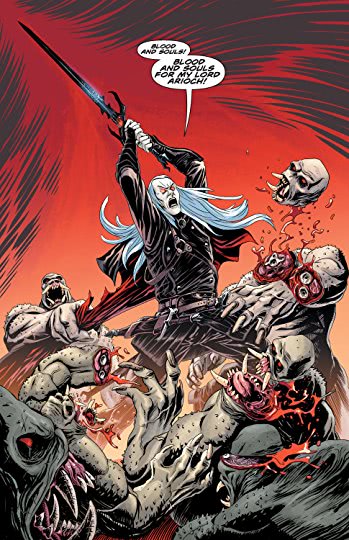Elric: Difference between revisions
1d4chan>Zimriel (Undo revision 891269 by 217.140.215.82 (talk) A bit redundant n'est-ce pas?) |
m (1 revision imported) |
(No difference)
| |
Revision as of 18:36, 18 June 2023

Elric of Melniboné is the famous Sword & Sorcery character invented by Michael Moorcock for his Eternal Champion novellas, first published in 1961. Elric VIII, 428th Emperor of Melniboné, is a member of an elf-like race of decadent, amoral, hedonistic, demon-worshipping, Chaos-aligned beings whose empire spans a weird alternate earth. Unfortunately he suffers from conditions that leave him both an albino and very physically frail; Elric is so sickly that he depends on regular doses of alchemic medicine just to be able to get out of bed. Despite this, he is an incredibly powerful sorcerer/warlock, with a particular covenant to a Lord of Chaos named Arioch, the patron of all Melnibonian emperors.
Unlike most others of his race, Elric has a conscience; he sees the decadence of his culture, which once ruled the known world, and worries about the rise of the Young Kingdoms, populated by humans, and the threat they pose to his empire. Because of his introspective self-loathing of Melnibonéan traditions, his subjects find him odd and unfathomable, and his cousin Yyrkoon (next in the line of succession, as Elric has no heirs) interprets his behavior as weakness and plots Elric's death.
An aspect of the Eternal Champion, Elric eventually comes to possess the rune-blade known as Stormbringer; a sapient, soul-eating sword that seeks to devour all things. From that moment, he is doomed to tragedy and loss, as everyone he ever knows and loves is ultimately consumed either by fate or by Stormbringer itself. In his final tale, after having used Stormbringer to destroy the Lords of Chaos and Order and create a new universe, Stormbringer plunges itself into Elric's chest, devouring its master in its final act of betrayal before taking its true demonic form to go and corrupt the new universe. Not unlike how Turin Turambar ended his life by way of Gurthang, but Moorcock hates when you point that out (he'd probably be less cross if you compare the death to that of Kullervo though).
Elric was envisioned by his creator as an antithesis to Conan the Barbarian; whereas Conan is a mighty warrior of a primitive culture who shuns magic and ultimately becomes a king despite his humble birth, Elric is sick and frail, hails from civilization in all its corrupt, decadent, soul-destroying malice, and a mighty sorcerer who depends on alchemy and the dark blessings of his daemon-blade to even walk, never mind fight, and is a born emperor who ultimately dies alone, unmourned, and unloved, having destroyed his entire empire. Ironically, the two DID meet in a two-part story in the early issues of the 1970s Conan comicbooks created by Marvel Comics.
/tg/ Relevance
In the beginning, there was the Dungeons & Dragons Law/Neutrality/Chaos alignment. This wore Moorcock's Law/Balance/Chaos conflict on its sleeve. Advanced Dungeons & Dragons added a more explicit Good/Evil axis to this basis, thus forming the Great Wheel ... and removing that Moorcockian conflict. Then Planescape (re)instituted the Blood War "but just for the bad planes" (well, that's what the clueless berks say). Elements of this still sputter around later editions and Pathfinder.
Meanwhile, whether involved in the law/chaos dustup or not, Moorcock's notion of multiple planes in a multiverse has been consistent in the D&D and post-D&D settings. For the latter, we have Beyond Countless Doorways.
Elric (along with Stormbringer) was listed in the first printing of that AD&D Deities & Demigods rule book. However, Chaosium already had a role playing series in the works based on Elric & Stormbringer and the initial AD&D printing was not fully authorized. A mutually beneficial deal was worked out between Chaosium and TSR, yet TSR chose to remove Elric from later printings of Deities & Demigods. Didn't stop White Plume Mountain from ripping off the sword for Blackrazor.
The world of Elric's Young Kingdoms was the setting of the Stormbringer role-playing game by the publisher Chaosium (Hawkmoon has also been so treated, as has Corum). After a disagreement between Moorcock and Chaosium, the Stormbringer line was discontinued. In 1993 Chaosium released Elric! which still used their BRP system. Its main difference was in the way magic through demon summoning was detailed and the allegiance system that saw characters lean either towards law, chaos or the balance, themes that underscored the books. Subsequently, a new version called "Elric of Melnibone" was published by Mongoose Publishing under their Runequest system.
Dragon Lords of Melnibone is a d20 System adaptation of the aforementioned "Elric!" game.
Elric's nickname "the White Wolf" inspired White Wolf, Inc. Founders Steven and Stewart Wieck were fans of the character, and named their roleplaying game magazine, and later their company, after him. Before that company collapsed into its own arsehole.
Elric himself inspired the Black Blade Magus archetype in Pathfinder, and two aspects of the Warlock (the Hexblade patron and the Pact of the Blade class feature) in Dungeons & Dragons 5th Edition.
The metaphysical battle between the forces of Order & Chaos went on to inspire the Chaos faction in Warhammer Fantasy (and its subsequent Warhammer 40,000 spin-off). Although the dual Egyptian godesses of Ma'at and Isfet do predate the books by several thousand years, so the idea was already in the public domain.
The Elves of Warhammer Fantasy Battle were clearly based on the Melnibonians, mostly by splitting up different aspects. The High Elves have the basic "gray" aspects of Melnibonians, being long lived, pointy eared expert magic users on a mysterious island, with a crazy powerful navy, caverns of sleeping Dragons waiting the last battle against Chaos, and an aloof deploring attitude towards the upstart young races. However, the Chaos-worship (downplayed in WFB compared to Elric), obscene decadence, rampant cruelty, use of black magic, and overarching sociopathy is the purview of the Dark Elves.